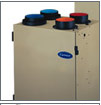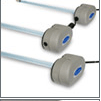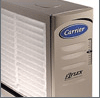|
|
Indoor Air Quality
How is the
quality of your indoor air?
A study by the
U.S. Environmental Protection Agency (EPA) found that indoor air can actually
be more polluted than the air outdoor. Considering that most Americans spend up
to 90 percent of each day indoors, you may be experiencing indoor air pollution
without even knowing it.
Today, homes and
buildings are sealed more tightly to conserve energy. Unfortunately, this seals
in mold, pollen, bacteria and other pollutants. Since the EPA ranks indoor air
pollution among the top five environmental risks to public health, there is
a reason to be concerned.
Ventilators, Air Cleaners, UV lights and
Humidifiers work with your HVAC equipment to purify and enhance the air quality
in your home. Each offers a distinct method for an overall clean air solution.
 |
Ventilation systems replace a portion of stale indoor air with
fresh outdoor air, reducing energy loss in the process. Air exchangers for
instance, let users manually or automatically adjust the fresh air flow. The
units retain energy used to heat or cool, saving money on utility bills.
|
 |
Ultraviolet air
treatment systems or UV Lamps are designed to prevent mold spore
growth on air conditioning coils. This technology, used for decades in water
treatment, helps reduce allergic reactions to mold while enhancing overall air
quality
|
 |
Air cleaners offer an effective way to remove up to 99.98% of
the particles - dust, pollens, pet dander, plant spores, fungi, bacteria,
tobacco smoke, etc. - from the air that passes through the home. York offers both
electronic and media air cleaners.
|
Duct Leaks. Did you know that leaks in your duct system can have substantial costs on your energy bill and indoor comfort? Duct leaks can also affect the quality of your indoor air. Find out more about duct leaks and how we can help!
|
|